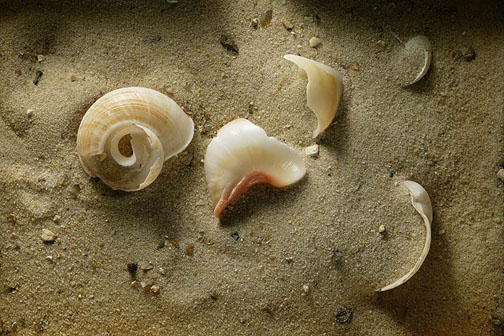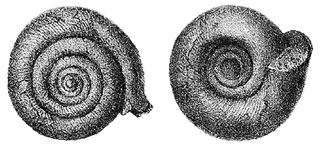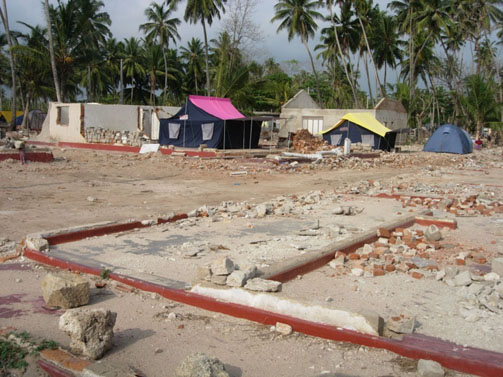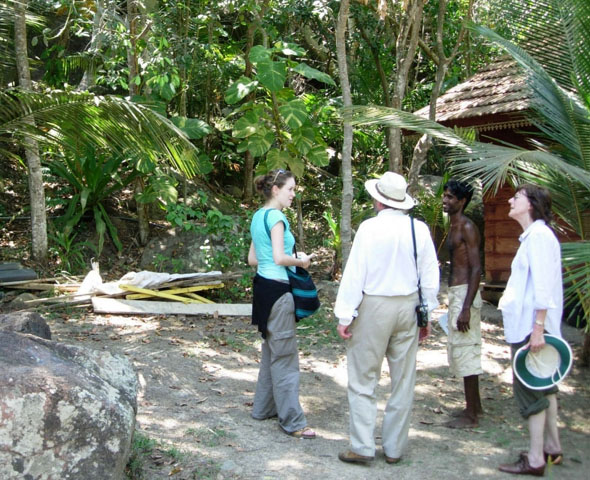

Fred Naggs1, Dinarzarde Raheem1,2 and Elizabeth Platts3
1Department of Zoology, The Natural History Museum, London SW7 5BD. F.Na...@nhm.ac.uk
2Department of Zoology, University of Cambridge, Cambridge CB2 3EJ,
329 Mawson Road, Cambridge CB1 2DZ

Fig. 1. On the beach at Unawatuna. From left to right: Cyclophorus sp., Acavus haemastoma, Anodontia ovum and Pythia ceylanica on upper right
For the past ten years two of us (Dinarzarde Raheem and Fred Naggs) have been investigating the Sri Lankan snail fauna, particularly since 1999 with the commencement of the Darwin Initiative project Land snail diversity in Sri Lanka. This was a capacity-building, survey-based project working with the Department of National Museums in Colombo and Peradeniya University. With post-project funding from the Darwin Initiative we are currently working with the Sri Lankan Wildlife Heritage Trust and carrying out investigations under the project Land snails as models for biodiversity assessment in Sri Lanka. The land snail fauna is diverse and highly endemic with the greatest diversity and endemism concentrated in the remaining rainforests in the southwest. These forests are now highly fragmented and occupy a total area less than half that of Greater London. About 250 land snail species are currently recognised but approaching 40% of the species found in our surveys were undescribed and a very rough estimate of the total number of land snail species for Sri Lanka might be about 400. Describing this diversity, understanding its origins, investigating distributions and how they are affected by environmental change is the focus of our current work. An urgent need is to contribute to a body of knowledge that will allow informed decisions to be made about conservation strategy.
The events of 26th December 2004 when a tsunami swept across the Indian Ocean provide a framework for presenting a few of the incidental but interesting observations we have made during our programme. We can be thankful that most of us spend our lives in a largely benign world where tragedies are generally local and personal and we do not expect to be swept away by major catastrophes. The recent tsunami is a salutary reminder of the earth's capacity to dwarf our own destructive powers. One of us, Dinarzarde Raheem, was safely in Colombo on the morning of 26th while Fred Naggs visited in mid January and again with his wife Susie in February to early March 2005 for a planned holiday. In February Fred and Susie met up with our Society Treasurer, Elizabeth Platts, and her daughters Victoria and Sarah. Sarah had been living in Sri Lanka since October 2004. Our plans for a tour around the south and south east of the island had to be dropped because the accommodation booked near Yala National Park and at Pottuvil had been obliterated by the tsunami with considerable loss of life. Instead we shared the stunning beauty and historical wonders of Sri Lanka's interior.
Before returning to the UK we decided to visit the south of the island. The visit to Unawatuna, just east of Galle was undertaken with reservations. Because of the immediacy of the human tragedy, we were uncomfortable about visiting the area and intruding on the widespread suffering. However, Sarah had an extremely close escape from the tsunami and the deciding consideration was the need for Sarah to visit the scene with her family and for them all to come to terms with her traumatic experience. That was why we were there but, as witnesses to the aftermath of the tsunami, and in no sense indifferent to the human suffering around us, it was nevertheless important to view the event as a major environmental and biological phenomenon and for this we looked at the snails.
Because of the largely temporary nature of most terrestrial/freshwater sedimentary deposits, the prospect for long-term survival of fossils of terrestrial organisms is poor. So we should not be surprised to learn that the occasions on which terrestrial organisms are washed out to sea to be incorporated in rapidly laid down offshore marine deposits are important fossilization events. Although the Deccan Plate probably possessed a rich Gondwanan land snail fauna, very little of it has been found in the Mesozoic fossil record. Much of what existed would have been buried under the Deccan Traps and the only records are those of Anchistoma sensu Stoliczka, a few corilliform shells dated between 90-67 Ma, which were found in shallow marine deposits in southeastern India in the mid-nineteenth century. It can be imagined that these were deposited in events similar to the recent Indian Ocean tsunami.
 Anchistoma sensu Stoliczka, 1867. Mesozoic corilliform
shells thought to be related to modern Corilla, which is
represented by 10 Sri Lankan species and one from South India. The
fossils are in deposits mixed with a shallow marine fauna and were
laid down at 90 and 67 Ma, around the time that Madagascar split
from the Deccan plate and 2 Ma before the K/T boundary. [NHM copyright]
Anchistoma sensu Stoliczka, 1867. Mesozoic corilliform
shells thought to be related to modern Corilla, which is
represented by 10 Sri Lankan species and one from South India. The
fossils are in deposits mixed with a shallow marine fauna and were
laid down at 90 and 67 Ma, around the time that Madagascar split
from the Deccan plate and 2 Ma before the K/T boundary. [NHM copyright]
The true status of corilliform fossils is difficult to determine but modern Corilla is represented by ten species in Sri Lanka with just one species from the Anamalai Hills in southern India. Before the coastal forests were cleared in southwestern Sri Lanka Corilla would have been common and widespread in low-lying areas. However, Corilla is no longer a major component of coastal areas and it was not found among the land shells seen along the beach at Unawatuna. However, beach-worn individuals of other land snails outnumbered marine shells and were present in significant numbers, particularly examples of Acavus haemastoma. Finding odd individuals of Acavus on a beach is not unusual. They seem to be sought out by hermit crabs and the shells can be seen making uncharacteristically rapid progress propelled by their residential guests. However, it was clear that the vast majority of the snails at Unawatuna were victims of the tsunami and having been washed out to sea, were being deposited along the strand line, mostly as fragments. From the amount of surface soil removed by the tsunami it is clear that, in addition to the many human victims, whole communities of organisms were swept out to sea and many would have been rapidly covered by silt. This clearly has the makings of a major fossilization event that extended around the Indian Ocean.
Acavus is interesting for a number of reasons. Acavus and Oligospira form a group of closely related species endemic to Sri Lanka that, as with Corilla, can be described as living fossils having a Godwanan or possibly Pangaean origin. We had identified a highly polymorphic population for future study with a high density of individuals in a readily accessible home garden location just inland from the coast road at Welhengoda. A visit to this site in January 2005 by our project colleague, Wasana Perera, revealed an area swept clean by the tsunami with only bare sand remaining and no sign of Acavus.
Acavus haemastoma possesses a stunningly beautiful shell that is polymorphic for banding and background and lip colour, which is reminiscent of that found in European Cepaea. This has long puzzled population geneticists who associate the maintenance of such polymorphism with visually selected predation, most notably by thrushes. The puzzlement is due to the received information that the shells of Acavus are covered in a dark algal film that masks the polymorphic colour and patterns that would therefore be irrelevant to selection and maintenance by visual predation. With Acavus haemastoma only some individuals are covered in algae and many seem to be free of it. Thus some are cryptic and others exhibit dymantic polymorphic patterns that could prove of value in overcoming the search image hunting strategy attributed to some visual predators. The mechanism by which some Acavus haemastoma are covered in algae and others are completely free of algae is unknown. Occasional bird predation on Acavus by the Crested Serpent Eagle Spilornis cheela and the Southern Coucal Centropus sinensis has been observed but little is known of predation levels on Acavus. Predation on Acavus is unlikely to be high because they have a k-selected reproductive strategy with a high investment in very large, thrush-sized eggs that are laid singly.
We have found what appear to be bird anvils surrounded by broken shells and shell middens secreted away in holes in trees but unexpectedly, these have been dominated by the unpatterned shells of Corilla. In 1998 on the summit of Doturugala, one of the main peaks in the Peak Wilderness range of the Central Highlands we observed a mound of about 80 shell fragments (54 fragments of Corilla erronea, 8 fragments of a Theobaldius sp. and 12 fragments of Cryptozona ceraria). The shells were collected in a little heap close to a small stone that may have been used for cracking the shells open. We suspect that either a small mammal such as a mongoose or civet or a bird such as the endemic Spot-winged Ground-thrush Zoothera spiloptera or the Ceylon whistling-thrush Myophonus blighi had collected the shells. Both species of thrush occur in the montane rainforests of the Central Highlands.
In addition to snail bodies being a valuable source of animal protein their shells are an important source of calcium carbonate, which in the acidic leaf litter of many tropical forest habitats may be in short supply. The empty robust shells of Cyclophorus are often found broken up in a way suggesting that the shells have been eaten and other snails will directly radulate empty shells.
A further project was planned to investigate the correlation of an oxygen isotope profile during successive growth at the shell's mantle edge with that of rainfall. Early investigators had claimed that Acavus spends much of its life in trees where it feeds on algae and lichen. This was of enormous interest to us because if this was true it would be expected that much of the oxygen incorporated into the shell's calcium carbonate would be derived from rainfall close to the time of its precipitation. It is well established that different sources of rainfall exhibit distinctive and characteristic oxygen isotope profiles. Thus, for example, the southwest monsoon has a recognizably different oxygen isotope profile to that of the northeast monsoon. It appears that Acavus reaches adult size in about one year so, from the growth lines beginning from beyond the embryonic whorls to close to the adult mantle margin might hold an annual oxygen isotope profile corresponding to that of the year's rainfall following hatching of the snail. The reason we were so interested in this was because there are a few rich cave deposits in Sri Lanka with numerous shells mostly Acavus, some of which go back about 30,000 years. Thus there was the potential to construct a detailed record of monsoon patterns extending well into the last ice age, something of enormous interest to climatologists. However, our observations of Acavus in traditional village home gardens suggest that the early investigators were wrong about Acavus feeding behaviour. In the populations that we observed snails did spend daylight hours up in trees and bushes but at night they rapidly descended to the ground and congregated to feed on rotting fruit. Their uptake was therefore of ground water and there was not the hoped for detailed record of rainfall origin. We still know nothing of the feeding behaviour of Acavus in natural forest habitats, which may be very different, and the potential for pursuing this line of enquiry has not been exhausted. Anticipating the nature of climate change is a key consideration for developing conservation strategies and information about past rainfall patterns would be valuable for developing models of future climate.
Within the confines of Sri Lanka the climate is diverse and habitats range from dry scrub forest to lowland and montane rainforest. Changing patterns of climate through time interacting with the high topographic diversity in Sri Lanka, combined with long periods of isolation for the rainforests, may have contributed to the establishment of high species diversity and the high degree of endemism. In the past it would have been possible for snail distributions to accommodate to changing climate and shift through the mosaic of different but continuous forests that naturally enveloped the country. Now that forests are isolated into fragments the capacity for populations to shift is restricted to the limited number of species that can exploit transformed habitats. While some species do well in traditional village home gardens other transformed habitats such as tea estates are largely devoid of native species. It is the combination of forest fragmentation with climate change that could sound the final death knell for tropical biodiversity.
Thus, in addition to conserving all remaining wet zone forest in Sri Lanka, a conservation priority is to establish forest corridors. Working with the Sri Lankan Wildlife Heritage Trust, Rohan Pethiyagoda, the Trust's founder and Managing Trustee and Mohomed Bahir, researcher, we plan to contribute to this strategy. A block of degraded tea estate at Agrapatana at 1,700m above sea level has been purchased by the WHT for a reforestation project. In addition to restoring natural plant diversity a measure is needed to show the extent to which this project is successful in establishing a diverse biota. To this end we plan to work with the WHT to utilise the value of snails as a key indicator group. Detailed snail surveys will be carried out in surrounding natural forests to serve as a baseline by which the success at Agrapatana might be measured.
We would like to take this opportunity to thank friends, colleagues, relatives and neighbours for generously contributing funds and clothing for emergency relief in Sri Lanka. In addition to making financial donations to the temporary Tsunami Disaster Relief Fund set up by the Centre for Policy Alternatives, Colombo, Sri Lanka, we were able to take some direct action on the ground. For this we are particularly grateful to Wasana Perera for collecting and clearing the shipment we sent out in early January and distributing it to the needy, and to Perma International for sending the shipment at cost price. A tiny contribution but it all helped. We are also grateful to Jetwing Eco Holidays, Sri Lanka, for efficiently dealing with our changed itinerary when they were coping with the loss of clients, friends and colleagues.
To understand current tectonic events and the historical origins of Sri Lanka's snail fauna requires a step back in time to the Mesozoic origins of the Deccan or Indian tectonic plate. Palaeomagnetic records support a history of the Deccan Plate in which it separated from the southern continent of Gondwana at about 130Ma and, after breaking away from Madagascar around 90Ma, rafted across the Tethys Ocean to make land contact with Asia at about 30Ma. The ongoing collision of the Deccan and Eurasian plates has been described as the most profound tectonic event in the past 100Ma. The leading submarine plate margin may have made contact with Asia at the 65Ma K/T boundary and one current hypothesis is that the massive energy generated by this collision of continents could have given rise to the devastating volcanism and lava flows that formed the Deccan Traps. Although the Chicxulub meteorite impact has dominated explanations for the K/T extinctions for the past few decades, a strong case remains for arguing that the Deccan Traps were primarily responsible for K/T extinctions.
As the southernmost part of the Mesozoic island Deccan Plate it could be that the land area currently composing Sri Lanka was part of a refuge from the devastating impact of the trap lava as it flowed across most of the Deccan Plate land mass. In fact coastal margin reconstructions for the K/T boundary show a much smaller more isolated island on an area currently occupied by a part of southern Sri Lanka. The Gondwanan fauna in contact with the traps would have been obliterated and, when land contact was made with Asia, recolonisation across the traps would have been in competition with a northern fauna. This may be why Sri Lanka has several snail groups thought to have ancient origins in Gondwana that are poorly represented in or completely absent from India. This scenario is complicated by evidence that other fragments of Gondwana may have been assimilated into the Deccan Plate during its rapid movement north but the timing for this is not clear. An additional complication from the European Mesozoic fossil record is that our supposed Gondwanan taxa appear to have been part of what was a Pangaean fauna. We have some considerable way to go before South Asian faunal origins are unraveled.
Sri Lanka is an integral part of the Deccan Plate currently separated from India by the shallow and narrow Palk Straits. It has repeatedly been connected to the mainland, most recently about 10,000 years ago. More significant than the current sea channel in isolating and shaping Sri Lanka's distinctive, highly diverse and endemic land snail fauna has probably been the fact that the rainforests in the south-west of the island are isolated from the seasonal rainforests of India's Western Ghats. This climate pattern with extensive arid zones in northern Sri Lanka and southern India appears to have a longer history than Sri Lanka's current island state.
Deccan Trap flows and early formation of the Himalaya possibly represented the peak of post-collision tectonic activity. However, fossil evidence indicates that, among other effects, major tectonic events during rafting of the Deccan Plate generated massive flooding that washed terrestrial species out to sea. Thus massive inundation of the sea onto coastal areas of the Deccan Plate predated Asian contact and, as we have just been made brutally aware, such flooding is not confined to the distant past.
Further information about the Deccan traps and the frequency of tsunami can be found here.
The aftermath of a tsumani

A house was here. Damage on the coast was widespread with massive loss of life.

Sarah, on left, explains to Elizabeth and Fred how she escaped from the hut on the right (here rebuilt) just before the tsunami struck. Sarah owes her life to the shouted warning from A.P.G. Lakshman Karunarathna (looking on) and the proximity of the small hill behind. With stiff competition from a very agitated Brahminy cow, Sarah and her friends managed to scramble up the rocks to safety. The hill, incidentally, was inhabited by a large population of Pythia ceylonica.